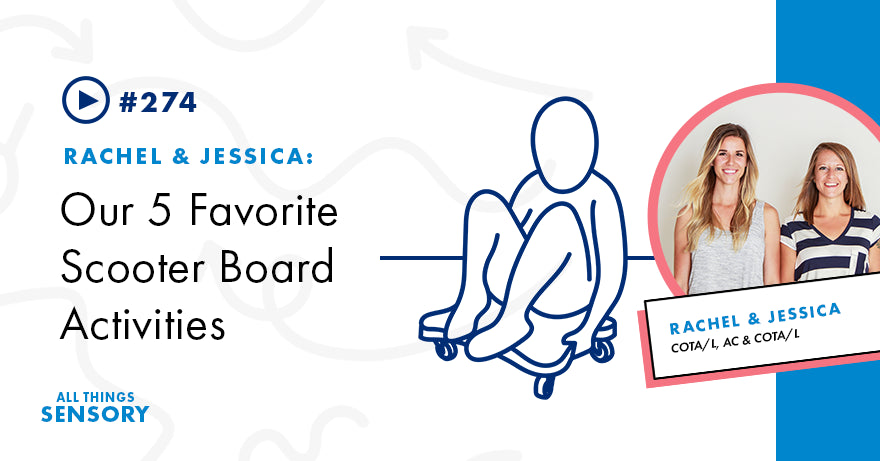Your Cart is Empty

The scooter board is a common therapeutic tool used in just about every clinic and school. It’s a simple, effective tool that targets a ton of underlying skills. Because it’s one of our favorite pieces of equipment to use in a treatment session, we decided to dedicate an entire episode to it!
We are giving you 5 fun, therapeutic activities using a scooter board that you should try including into your next treatment session! Be sure to modify as needed to meet your client’s needs!
Parents! This episode is also great for YOU! Try some of these activities with your child and add them into the daily sensory diet routine!
Scooter Board (Amazon)
Gross Motor Skills Activity Course
Make sure to check out all of our links below!
Skylight Calendar - Use Code SENSORY for $30 off your purchase
We’d love to answer your questions on the podcast! Fill out this form -> https://harkla.typeform.com/to/ItWxQNP3
Looking for more in-depth help? Sign up for 2-on-1 Mentoring With Us!!
All Things Sensory Podcast Instagram
Harkla YouTube Channel
Harkla Website - Shop Sensory Products!
Harkla Instagram
Episode 194 The Just Right Challenge
The scooter board is undeniably one of the key therapeutic tools in occupational therapy. It holds a prominent position in the weekly activities of many therapists, offering a wide range of engaging experiences and playing a vital role in facilitating therapy sessions.
A scooter board is a flat plastic board with four wheels on the bottom, sometimes equipped with handles. Unlike the standing scooters with two or three wheels, these rectangular ones allow sitting or lying on them.
They are commonly used in occupational therapy to enhance balance, coordination, strength, and motor planning skills. These boards also come in various sizes and colors, catering to the unique needs of each individual.
Operating a scooter board is straightforward but requires specific techniques to ensure safety and optimal performance. First and foremost, confirm that the wheels are not locked and that the rolling surface is suitable.
To move the board, utilize either your feet or hands, propelling it in various directions - forward, backward, or side-to-side. Maintaining a solid core and good posture while using the board is crucial.
Integrating a scooter board into various functional settings offers tremendous benefits. Its versatility opens up countless possibilities during therapy sessions, making it an indispensable tool.
Here are five ways to enhance progress in your next session by incorporating a scooter board:
These activities are suitable for toddlers, teens, and adults of all ages and can be customized to offer a stimulating experience for every child.
The Supine Wall Push
Scooter Board As An Ab Roller
You can choose between two hand placements on the scooter board for this activity. Such as:
Place your hands on the scooter board handles
Place your hands flat on the surface of the scooter board.
Propelling Yourself With Your Feet While Seated
Prone On The Scooter Board While Reading A Visual Chart
Supine Scootering While Putting Rings On A Cone
Lie on your back (supine) and skillfully position rings onto cones or delicately balance balls atop cones.
Ensure that you turn your head from left to right while placing the item, ensuring proper placement and positioning.
You can use a ball or a stuffed animal to encourage tucking the chin towards the chest.
Maximizing the effectiveness of scooter board activities requires engaging and meaningful tasks. Simply propelling oneself down the ramp in a superman extension and repeatedly pulling oneself back up falls short of meeting this criteria.
Incorporating pretend play scenarios can engage a child's imagination and provide a fun and functional way to practice motor skills. This interactive approach not only sparks creativity but also enhances their physical development.
It is essential to customize activities based on a child's abilities and interests while ensuring a safe and enjoyable experience that targets specific areas of development. With the proper techniques and activities, a scooter board can be a valuable addition to any therapy session.
BORING, BUT NECESSARY LEGAL DISCLAIMERS
While we make every effort to share correct information, we are still learning. We will double check all of our facts but realize that medicine is a constantly changing science and art. One doctor / therapist may have a different way of doing things from another. We are simply presenting our views and opinions on how to address common sensory challenges, health related difficulties and what we have found to be beneficial that will be as evidenced based as possible. By listening to this podcast, you agree not to use this podcast as medical advice to treat any medical condition in either yourself or your children. Consult your child’s pediatrician/ therapist for any medical issues that he or she may be having. This entire disclaimer also applies to any guests or contributors to the podcast. Under no circumstances shall Rachel Harrington, Harkla, Jessica Hill, or any guests or contributors to the podcast, as well as any employees, associates, or affiliates of Harkla, be responsible for damages arising from use of the podcast.
Keep in mind that we may receive commissions when you click our links and make purchases. However, this does not impact our reviews and comparisons. We try our best to keep things fair and balanced, in order to help you make the best choice for you.
This podcast should not be used in any legal capacity whatsoever, including but not limited to establishing “standard of care” in a legal sense or as a basis for expert witness testimony. No guarantee is given regarding the accuracy of any statements or opinions made on the podcast.
Comments will be approved before showing up.